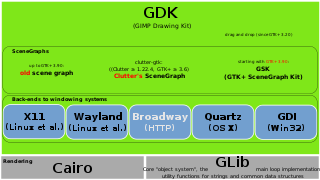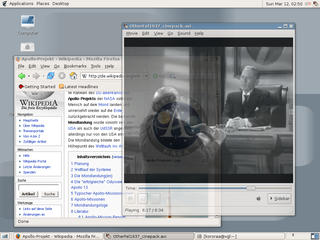AppleTalk is a discontinued proprietary suite of networking protocols developed by Apple Computer for their Macintosh computers. AppleTalk includes a number of features that allow local area networks to be connected with no prior setup or the need for a centralized router or server of any sort. Connected AppleTalk-equipped systems automatically assign addresses, update the distributed namespace, and configure any required inter-networking routing.

WordPerfect (WP) is a word processing application, now owned by Corel, with a long history on multiple personal computer platforms. At the height of its popularity in the 1980s and early 1990s, it was the dominant player in the word processor market, displacing the prior market leader WordStar.
A network operating system (NOS) is a specialized operating system for a network device such as a router, switch or firewall.
pSOS is a real-time operating system (RTOS), created in about 1982 by Alfred Chao, and developed and marketed for the first part of its life by his company Software Components Group (SCG). In the 1980s, pSOS rapidly became the RTOS of choice for all embedded systems based on the Motorola 68000 series family architecture, because it was written in 68000 assembly language and was highly optimised from the start. It was also modularised, with early support for OS-aware debugging, plug-in device drivers, Internet protocol suite (TCP/IP) stacks, language libraries, and disk subsystems. Later came source code level debugging, multiprocessing support, and further computer networking extensions.

The Graphics Device Interface (GDI) is a legacy component of Microsoft Windows responsible for representing graphical objects and transmitting them to output devices such as monitors and printers. Windows apps use Windows API to interact with GDI, for such tasks as drawing lines and curves, rendering fonts, and handling palettes. The Windows USER subsystem uses GDI to render such UI elements as window frames and menus. Other systems have components that are similar to GDI; for example: macOS has Quartz, and Linux has X Window System and Wayland.

Novell, Inc. was an American software and services company headquartered in Provo, Utah, that existed from 1980 until 2014. Its most significant product was the multi-platform network operating system known as Novell NetWare.

An MFP, multi-functional, all-in-one (AIO), or multi-function device (MFD), is an office machine which incorporates the functionality of multiple devices in one, so as to have a smaller footprint in a home or small business setting, or to provide centralized document management/distribution/production in a large-office setting. A typical MFP may act as a combination of some or all of the following devices: email, fax, photocopier, printer, scanner.
GeoPort is a serial data system used on some models of the Apple Macintosh that could be externally clocked to run at a 2 Mbit/s data rate. GeoPort slightly modified the existing Mac serial port pins to allow the computer's internal DSP hardware or software to send data that, when passed to a digital-to-analog converter, emulated various devices such as modems and fax machines. GeoPort could be found on late-model 68K-based machines as well as many pre-USB Power Macintosh models and PiPPiN. Some later Macintosh models also included an internal GeoPort via an internal connector on the Communications Slot. Apple GeoPort technology is now obsolete, and modem support is typically offered through USB.
Zero-configuration networking (zeroconf) is a set of technologies that automatically creates a usable computer network based on the Internet Protocol Suite (TCP/IP) when computers or network peripherals are interconnected. It does not require manual operator intervention or special configuration servers. Without zeroconf, a network administrator must set up network services, such as Dynamic Host Configuration Protocol (DHCP) and Domain Name System (DNS), or configure each computer's network settings manually.

NetWare is a discontinued computer network operating system developed by Novell, Inc. It initially used cooperative multitasking to run various services on a personal computer, using the IPX network protocol.
The Internet Printing Protocol (IPP) is a specialized Internet protocol for communication between client devices and printers. It allows clients to submit one or more print jobs to the printer or print server, and perform tasks such as querying the status of a printer, obtaining the status of print jobs, or cancelling individual print jobs.
IPX/SPX stands for Internetwork Packet Exchange/Sequenced Packet Exchange. IPX and SPX are networking protocols used initially on networks using the Novell NetWare operating systems. They also became widely used on networks deploying Microsoft Windows LANS, as they replaced NetWare LANS, but are no longer widely used. IPX/SPX was also widely used prior to and up to Windows XP, which supported the protocols, while later Windows versions do not, and TCP/IP took over for networking.
In computers, a printer driver or a print processor is a piece of software on a computer that converts the data to be printed to a format that a printer can understand. The purpose of printer drivers is to allow applications to do printing without being aware of the technical details of each printer model.
USB communications device class is a composite Universal Serial Bus device class.

Xgl is an obsolete display server implementation supporting the X Window System protocol designed to take advantage of modern graphics cards via their OpenGL drivers, layered on top of OpenGL. It supports hardware acceleration of all X, OpenGL and XVideo applications and graphical effects by a compositing window manager such as Compiz or Beryl. The project was started by David Reveman of Novell and first released on January 2, 2006. It was removed from the X.org server in favor of AIGLX on June 12, 2008.
Novell Embedded Systems Technology (NEST) was a series of APIs, data formats and network protocol stacks written in a highly portable fashion intended to be used in embedded systems. The idea was to allow various small devices to access Novell NetWare services, provide such services, or use NetWare's IPX protocol as a communications system. Novell referred to this concept as "Extended Networks", and when the effort was launched they boasted that they wanted to see one billion devices connected to NetWare networks by year 2000. NEST was launched in mid-1994 countering Microsoft's similar Microsoft at Work efforts, which had been launched in 1993.
A Bluetooth stack is software that is an implementation of the Bluetooth protocol stack.
Windows Vista has many significant new features compared with previous Microsoft Windows versions, covering most aspects of the operating system.
Comparison of the Java and .NET platforms.

GroupWise is a messaging and collaboration platform from Micro Focus that supports email, calendaring, personal information management, instant messaging, and document management. The GroupWise platform consists of desktop client software, which is available for Windows,, and the server software, which is supported on Windows Server and Linux.






